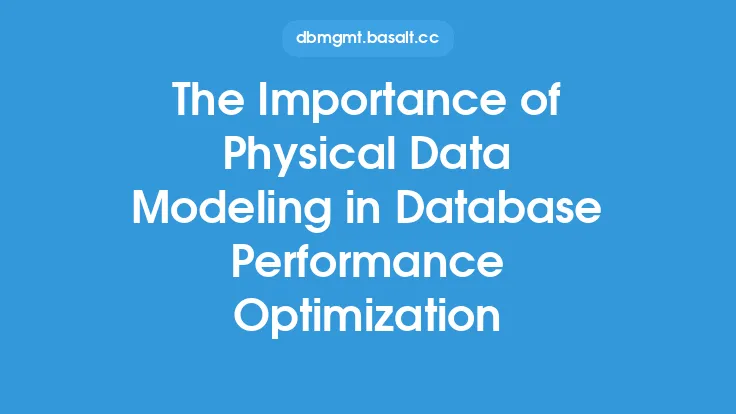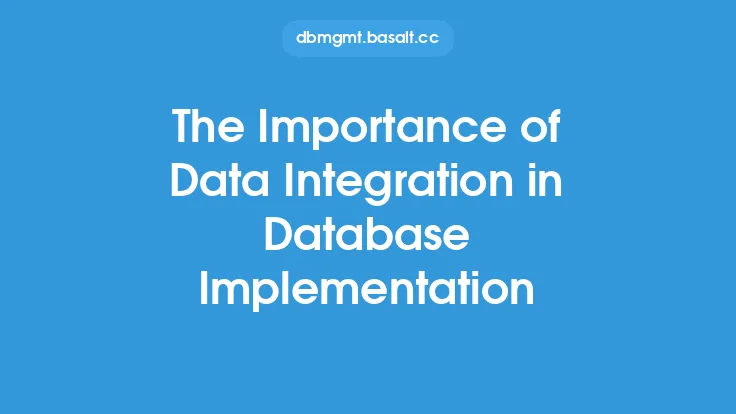Data modeling is a crucial step in the database schema implementation process, as it enables organizations to create a conceptual representation of their data assets. This process involves identifying the key entities, attributes, and relationships that are relevant to the business, and then using this information to design a database schema that meets the organization's needs. In this article, we will explore the importance of data modeling in database schema implementation, and discuss the key concepts and techniques that are involved in this process.
Introduction to Data Modeling
Data modeling is a discipline that involves creating a conceptual representation of an organization's data assets. This involves identifying the key entities, attributes, and relationships that are relevant to the business, and then using this information to design a database schema that meets the organization's needs. Data modeling is an essential step in the database schema implementation process, as it enables organizations to create a database that is tailored to their specific requirements. A well-designed data model can help to ensure that the database is scalable, flexible, and easy to maintain, and that it provides a solid foundation for the organization's data management needs.
Key Concepts in Data Modeling
There are several key concepts that are involved in data modeling, including entities, attributes, and relationships. Entities are the objects or concepts that are being modeled, such as customers, orders, or products. Attributes are the characteristics or properties of these entities, such as customer name, order date, or product price. Relationships are the connections between entities, such as the relationship between a customer and an order, or between an order and a product. Data modeling involves identifying and defining these entities, attributes, and relationships, and then using this information to design a database schema.
Types of Data Models
There are several types of data models that can be used in database schema implementation, including conceptual, logical, and physical data models. Conceptual data models provide a high-level overview of the data assets and their relationships, and are often used to communicate with stakeholders and to identify the key entities and attributes that are relevant to the business. Logical data models provide a more detailed representation of the data assets and their relationships, and are often used to design the database schema. Physical data models provide a detailed representation of the database schema, including the tables, columns, and relationships that will be used to store the data.
Data Modeling Techniques
There are several data modeling techniques that can be used in database schema implementation, including entity-relationship modeling, object-role modeling, and dimensional modeling. Entity-relationship modeling is a technique that involves identifying the entities, attributes, and relationships that are relevant to the business, and then using this information to design a database schema. Object-role modeling is a technique that involves identifying the objects and roles that are relevant to the business, and then using this information to design a database schema. Dimensional modeling is a technique that involves identifying the key entities and attributes that are relevant to the business, and then using this information to design a database schema that is optimized for data warehousing and business intelligence applications.
Benefits of Data Modeling
Data modeling provides several benefits in database schema implementation, including improved data quality, improved data integrity, and improved scalability. A well-designed data model can help to ensure that the data is accurate, complete, and consistent, and that it is stored in a way that is efficient and scalable. Data modeling can also help to improve data security, by identifying the key entities and attributes that are relevant to the business, and then using this information to design a database schema that is secure and compliant with regulatory requirements.
Data Modeling Tools and Technologies
There are several data modeling tools and technologies that can be used in database schema implementation, including data modeling software, database management systems, and data integration tools. Data modeling software provides a graphical interface for creating and editing data models, and can help to simplify the data modeling process. Database management systems provide a platform for storing and managing the data, and can help to ensure that the data is secure and scalable. Data integration tools provide a way to integrate the data from multiple sources, and can help to simplify the process of creating a unified view of the data.
Best Practices for Data Modeling
There are several best practices that can be followed in data modeling, including involving stakeholders in the data modeling process, using a standardized data modeling notation, and testing the data model against the business requirements. Involving stakeholders in the data modeling process can help to ensure that the data model is relevant and useful to the business, and that it meets the organization's needs. Using a standardized data modeling notation can help to simplify the data modeling process, and can make it easier to communicate with stakeholders. Testing the data model against the business requirements can help to ensure that the data model is accurate and complete, and that it provides a solid foundation for the database schema.
Common Challenges in Data Modeling
There are several common challenges that can arise in data modeling, including data quality issues, data complexity, and stakeholder communication. Data quality issues can arise when the data is inaccurate, incomplete, or inconsistent, and can make it difficult to create a data model that is accurate and reliable. Data complexity can arise when the data is complex or nuanced, and can make it difficult to create a data model that is simple and easy to understand. Stakeholder communication can be a challenge when the stakeholders have different perspectives or requirements, and can make it difficult to create a data model that meets the organization's needs.
Conclusion
In conclusion, data modeling is a crucial step in the database schema implementation process, as it enables organizations to create a conceptual representation of their data assets. By identifying the key entities, attributes, and relationships that are relevant to the business, and then using this information to design a database schema, organizations can create a database that is tailored to their specific requirements. Data modeling provides several benefits, including improved data quality, improved data integrity, and improved scalability, and can help to ensure that the database is secure and compliant with regulatory requirements. By following best practices and using the right tools and technologies, organizations can create a data model that is accurate, complete, and reliable, and that provides a solid foundation for the database schema.





